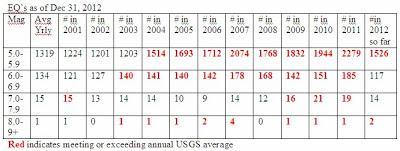
As far as 2013 data, we still have 8 weeks to go, but this is the running tally of number of quakes in the world in each of the four magnitudes I track. Data as always from USGS. The red means the number of quakes have met or exceeded USGS averages.
5.0-5.9 – 1169
6.0-6.9 – 110
7.0-7.9 – 15
8.0-9.9 - 2
The type and location of the quakes had also been diverse from times in the past. There were earthquakes at a deeper level than ever, or large quakes in places there had never been one (Svalbard, Norway).
USGS reported last week,
Earthquake Swarm Continues in Central Oklahoma
 "Since January 2009, more than 200 magnitude 3.0 or greater earthquakes have rattled Central Oklahoma, marking a significant rise in the frequency of these seismic events. "We've statistically analyzed the recent earthquake rate changes and found that they do not seem to be due to typical, random fluctuations in natural seismicity rates," said Bill Leith, USGS seismologist. "These results suggest that significant changes in both the background rate of events and earthquake triggering properties needed to have occurred in order to explain the increases in seismicity. This is in contrast to what is typically observed when modeling natural earthquake swarms."
"Since January 2009, more than 200 magnitude 3.0 or greater earthquakes have rattled Central Oklahoma, marking a significant rise in the frequency of these seismic events. "We've statistically analyzed the recent earthquake rate changes and found that they do not seem to be due to typical, random fluctuations in natural seismicity rates," said Bill Leith, USGS seismologist. "These results suggest that significant changes in both the background rate of events and earthquake triggering properties needed to have occurred in order to explain the increases in seismicity. This is in contrast to what is typically observed when modeling natural earthquake swarms." What they are saying there, is that there was a sudden and inexplicable change in at least two variables, presenting an unaccountable statistical anomaly, and that they dunno why.
As far as volcanic eruptions go, the Smithsonian Global Volcanism Program counts them. I searched the database from January 1, 1930 to December 31, 1939, and did the same for each decade through December 31, 2010. The plain number of eruptions is up. Click to enlarge.
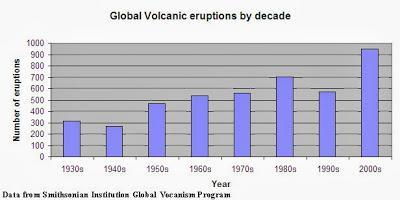 Raw data here
Raw data here1930s - 312
1940s - 269
1950s - 467
1960s - 537
1970s - 562
1980s - 703
1990s - 574
00-10 -950
In some volcano news, KURL8 out of Montana reports today that the lava pool under the supervolcano at Yellowstone is much bigger than thought.
"The lava pool beneath Yellowstone National Park is more than twice as big as scientists previously believed, that's according to new research from the Geological Society of America. Scientists from the University of Utah say the lake of molten lava is nearly 50 miles long and 12 miles wide."
For all that, scientists say that the real danger in that area is not from an eruption, since the geysers let off steam and pressure. It's from the earthquakes.
"Researchers analyzed, get this, 4,500 earthquakes in and around Yellowstone from 1985 to 2013. ... The last major earthquake in the area measured 7.3 and was in 1959. It was the most destructive earthquake ever recorded in the Rocky Mountains."
In other interesting volcano news, it was reported at a geology conference this week that remnants of a supervolcano have been found in Maine.
Maine's volcanoes (yes, Maine) among world's biggest
"Maine has supervolcanoes. Wait, Maine has volcanoes? Yes, and their eruptions could have been among the biggest ever on Earth, geoscientist Sheila Seaman reported here Tuesday (Oct. 29) at the Geological Society of America's annual meeting. ... Since they formed, the ancient volcanic layers have been tilted up by tectonic forces, providing a top-to-bottom slice through a supervolcano. For example, Isle au Haut, part of Acadia National Park, exposes the heart of a volcano. "The whole magma chamber is lying on its side," Seaman said."
The Most Active Volcano You’ve Never Heard Of
"In the extreme northeast region of Russia is the Kamchatka Peninsula. Familiar to people who play the board game Risk, Kamchatka is a huge mass of land sticking out into the north Pacific, and sitting on the peninsula is a cluster of volcanoes, some of them among the most active on the planet. The biggest of these is Klyuchevskaya Sopka, a monster stratovolcano towering over 4750 meters (15,500 feet) high. It’s also the most active, having been more-or-less erupting continuously since the late 1600s. It’s erupted a dozen times just since 2000! On Oct. 20, 2013, the Landsat 8 Earth-observing satellite flew over Klyuchevskaya, capturing a tremendously long plume of ash as well as two separate lava flows moving down the volcano’s flanks:
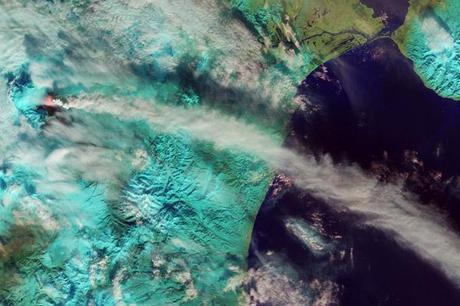
Isn't earth so interesting!!
I can't wait until we see it from that vantage point!
9,000-year-old painting of volcano linked to a real eruption
"A 9,000-year-old painting of an exploding volcano, the oldest ever found, can now be linked to a real-life eruption in Turkey. The towering Hasan Dag volcano erupted 8,970 years ago, plus or minus 640 years, according to a new dating technique that analyzes zircon crystals in volcanic rock, geochemist Axel Schmitt of the University of California, Los Angeles, reported here Wednesday at the Geological Society of America's annual meeting. Turkish scientists long suspected Hasan Dag was the source of the painting's dramatic scene, but never had a precise date for its volcanic rocks, Schmitt told LiveScience. The volcano is about 80 miles (130 kilometers) from the ancient village of Çatalhöyük, where the painting was discovered in 1964 during an archaeological dig."
(FMI on the painting itself, here is the article from Daily Mail)
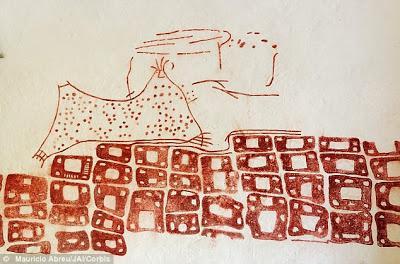
Daily Mail Caption: "A mural, pictured, found on a wall in the Turkish settlement of Catalhoyuk depicts a village in front of a volcano. The painting is thought to be a warning about the danger of nearby stratovolcano Mount Hasan, located 70 miles northeast from where the mural was found."
Turkey is interesting. The world's most mysterious and stunning archaeological site is there, Gobekli Tepe. I wrote about it in 2011 here.
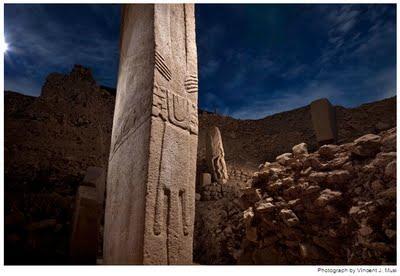
Some believe that the area of the Garden of Eden was in southern Turkey. Here is a map showing the nearby village of Catalhoyuk to the Turkish volcano Mount Hasan, and Gobekli Tepe's location. They are about 250 km apart or about 158 miles.
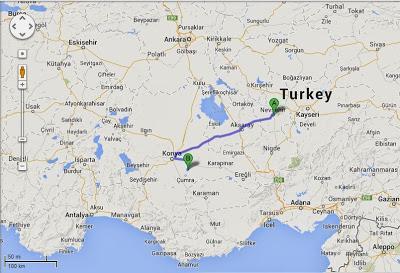
Horatio said, O day and night, but this is wondrous strange!Hamlet replied,
There are more things in heaven and earth, Horatio,
Than are dreamt of in your philosophy.
Volcanoes being discovered, restless earth, unknown paintings of long ago eruptions, and mysterious monoliths by disappeared rivers...there is so much we do not know but even as we partially know now, later we will fully know, by His grace. (1 Corinthians 13:12).
"How great is God--beyond our understanding! The number of his years is past finding out." (Job 36:26)
